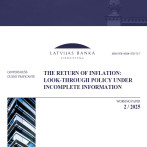Price flexibility in Latvia
Price and wage flexibility is one of the conditions determining how soon an economy can recover from a crisis. Therefore, price flexibility (what is it like in Latvia and is it more of a hindrance or a help right now) is one of the most important macroeconomic issues. The latest working paper of the Bank of Latvia has assessed consumer price flexibility by analysing the frequency and size of price changes in Latvia on the basis of a broad data base containing information on selected product prices in particular outlets.
The results of the working paper indicate that consumer prices are flexible in Latvia. It implies that companies do not have any major obstacles (such as low competitiveness or a high share of administered prices) to changing prices in Latvia, so they can react swiftly to economic developments. This ability to adapt quickly is confirmed by the last year data suggesting that the majority of companies shifted from a period of sharp price increases to decreasing prices in the rapidly changing situation.
In Latvia, companies change prices far more frequently than in the euro area and even somewhat more frequently than in the USA where prices are more flexible than in the countries of old Europe. In the euro area, every month on average 15.1% of prices were changed, in the USA – 24.8%, whereas in Latvia 28.7% from 2003 to 2009. One should certainly take into account the composition of the consumption or the average "shopping" basket in the USA and the euro area that is different from Latvia's, as the usually more flexible food and energy prices account for a significantly smaller share in the consumption basket in comparison with services the prices of which are changed less frequently. Nevertheless, also when comparing the frequency of price changes in specific groups of goods and services, one can see that it is higher in Latvia.
The large volume of data used for the working paper (185 products and 13 to 71 price series were observed for each of them) provided for a possibility to assess the ability of different groups of goods and services to adjust to changes in the economy. The working paper has compiled information on price changes in different product groups and their size. When comparing price flexibility in specific price groups, we see that the prices of fuel and food products are changed most frequently but those of services, particularly catering and hotel services, less frequently, and that is due to the fact that these services bear higher costs of adjusting prices that can even exceed the benefits gained.
The high price flexibility in Latvia is sure to partly reflect also the sharp inflation and wage growth as a result of which companies needed to adjust prices more frequently in 2007 and 2008, since the rapidly rising prices of other goods pushed up costs, and companies had a possibility to increase prices and income following the market trends. However, the frequency of price changes is only partly explained by the growing inflation, since price flexibility was significant also in 2003 when inflation was low.
How did the price dynamics change in 2009 when the overall price level decreased because of the crisis? When prices were falling, the price flexibility did not diminish and even strengthened with the average monthly price change amounting to 36.7%. On the one hand, it is attributed to the changes in tax rates at the beginning of 2009 that caused a price rise but, on the other hand, to the necessity to adjust to the circumstances of significantly deteriorating demand. What is surprising about the conclusions of the working paper is the fact that with demand weakening, the number of price increases was still large in the context of ever wider price drops – even when deducting the prices increased as a result of the tax growth. It implies that a large number of companies did not reduce the price level or applied reductions temporarily before returning to the previous level of prices.
The reason why such a tactics is possible is most likely rooted in consumer behaviour. What are the psychological and sociological factors underpinning the price-setting? Is a person in Latvia "programmed" to rising prices and thus can easily adapt to higher prices? Are there any differences in behaviour across different consumer groups?
The article was published on the website Delfi on 14 September 2010.
Textual error
«… …»






